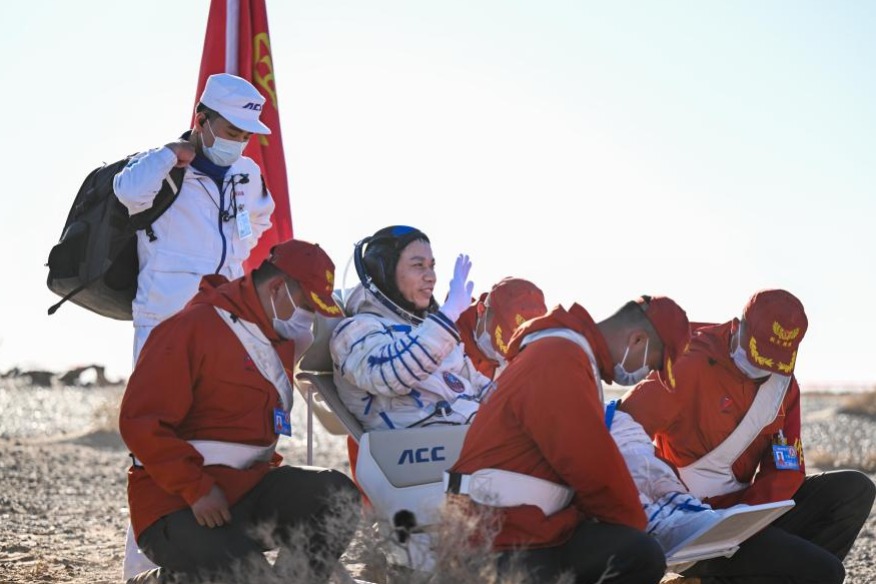NYC's Hart Island burial ground to open to the public
By BELINDA ROBINSON in New York | China Daily Global | Updated: 2023-04-13 10:22

Hart Island, the New York City cemetery that holds more than 1 million unclaimed dead buried since 1869 and amid the COVID-19 pandemic will open this year to the general public as a park.
The once secretive 131-acre grounds in Long Island Sound off the coast of the Bronx have been used to bury the city's poor, homeless, those with AIDS and others whose families couldn't immediately identify them. It is the nation's largest public cemetery.
Hart Island had been run by the city's Corrections Department since the 19th century. Prisoners from Rikers Island were used as gravediggers. In 2019, the New York City Council transferred that responsibility to the Parks and Recreation Department.
At least 1,100 burials still take place on the island each year. Most bodies arrive in plain wooden boxes by truck and get carried to a mass grave.
Family members of the deceased are allowed graveside visits by appointment twice a month. Now others will be able to visit.
Burials will continue to be the primary function of the island, and the Parks Department has said it will go to great lengths to maintain the dignity of burials.
"Hart Island remains a solemn burial ground for New Yorkers, and it will continue to be the city's municipal burial ground for the foreseeable future," Dan Kastanis, senior press officer for the Parks and Recreation Department, told China Daily.
The city is expected to spend $70 million to make over the site for visitors. There could also be tours by urban rangers this year to demystify the site.
There are talks to expand the city's "Weekend Adventure Series'' programs to the island, which include hiking, archery, fishing, nature classes and canoeing.
Now visitors can access the island only by a single ferry operated by the city, which used to transport the dead on morgue trucks from neighboring City Island.
More transportation to the island is being reviewed, and then visits will have to be prebooked. They won't take place on the same day as burials.
"In addition to the ongoing private gravesite visits for close family, we are exploring avenues for expanded public access led by our urban park rangers, who have decades of experience designing programs centered around culturally and historically sensitive topics," said Kastanis.
To get the park ready, undergrowth has been cleared, and the city's Design and Construction Department has removed 15 dilapidated buildings, according to The New York Times.
But a few sites have been kept, including a Catholic chapel from the 1930s and Cold War-era missile platforms.
The actual burial site, in the center of the island, has coffins laid on top of each other in trenches. Each plot has approximately 150 caskets or 1,000 infants. Babies who are stillborn are in their own section.
Gravesites are expected to stay as they are: no headstone or name, just white posts.
Melinda Hunt, director of The Hart Island Project, a nonprofit founded in 1994, has worked on improving access to the island and its burial data for decades.
Hunt told China Daily: "It's really a beautiful location, and there's no hierarchy as there are no markers, it's all GPS. It's not like going to the cemetery, and some people have these huge monuments, and some people have almost nothing. Everybody is buried much the same."
The mile-long cemetery's past includes its use as a training ground for a regiment of black Union Army soldiers in 1864. It also has been a prison camp during the Civil War, a psychiatric hospital, a drug rehabilitation center, a potter's field and a tuberculosis sanitorium.
Critics of Hart Island said that when it was run by the penal system, it was shrouded in secrecy, which made it hard for families to locate loved ones. The city's Human Resources Administration now handles burial records.
In 2018, The Hart Island Project digitally mapped gravesites using a drone and embedded geotiffs into 69,000 profiles in a project called the "Travelling Cloud Museum". That allowed people to add stories to its online database. Burial records range from the 1980s to the present day.
Hunt, a visual artist, has in the past helped families get copies of public burial records, arranged visits to gravesites and assisted families who want to use the island for a relative because they cannot afford a basic cremation costing $3,500.
"We get the burial ledgers from the city and the GPS burial location information and add that to our database so that people can look at where their relative is and they can add a story about their life. They can see where it is even if they can't visit right now," she said.
Hunt added: "It's taken a series of projects and effort to make Hart Island more visible, more accessible and more understood."
























